There are plenty of instructors in the StrongFirst community who have diverse skill sets, but few are as versatile as Artemis Scantalides. 16 years ago, she made the decision to leave a job in I.T. to pursue a career in the fitness industry and hasn’t looked back since.
Starting off as a personal trainer and SPIN instructor, Artemis eventually found kettlebell training and worked her way up to becoming an SFG Team Leader while also earning a black belt in kung fu.
In this exclusive interview, the former ballet dancer takes us inside her I’m Not Afraid to Lift course, shares the secrets of training Cirque du Soleil performers, and reveals how she overcame pressing problems to become the lightest conqueror of the Iron Maiden Challenge.
What’s the biggest barrier women face when considering strength training?
They’re often afraid about how it might change their body and think it might make them lose their feminine build. They also don’t want muscles like a man. I also meet a lot of women who are initially scared of getting hurt lifting, and this fear intimidates them into simply not trying.
How do you help them overcome these obstacles?
A little education goes a long way. I reassure them that it would take an awful lot of volume and work to get the physique of a man, as well as huge dietary changes. I let them know that yes, their body will change if they’re willing to put in the effort, but it will do so in ways that are beneficial to their health and appearance. If they’re older, these include maintaining the muscle mass we typically lose as we age and keeping their metabolism high.
Another key message is that kettlebell training transfers so well into everyday life. A deadlift mimics lifting a box or your kids, while loaded carries can help you lug groceries around. One of my clients told me that when she’s done playing on the floor with her child, she uses the get-up technique to return to standing.
When I can combine knowledge with continual small successes, people start to think, “Maybe she’s right” and believe in themselves more. Getting stronger and moving better creates a sense of self-efficacy that they can then apply to other challenges and learning experiences. Building competency with a kettlebell or any other training tool builds confidence, and they forget what they were so nervous about in the first place.
What’s the main contrast between working with general population students and the Cirque du Soleil performers you train?
The performers are all incredible athletes who are highly skilled in their particular craft. Their challenges are usually in the basics. A specialist like an aerialist mainly utilizes their upper body in both training and performance, and so often they don’t understand basic lower body patterns like the hinge and squat, unless they’re former gymnasts. Contortionists also have less lower body awareness than you might expect, despite being amazingly proficient in their discipline. That gives us an opportunity to work on things that might seem very simple but are helpful in real life. Teaching them how to do the basics well also helps them reduce their risk of injury away from the stage.
What scheduling considerations do you have to take into account?
The artists typically perform 10 shows a week, so I have to be mindful that whatever I do with them cannot make them too sore to go out on stage and practice their art at full capacity. This means we usually keep the intensity and volume lower than I would when working with other athletes or even the general population.
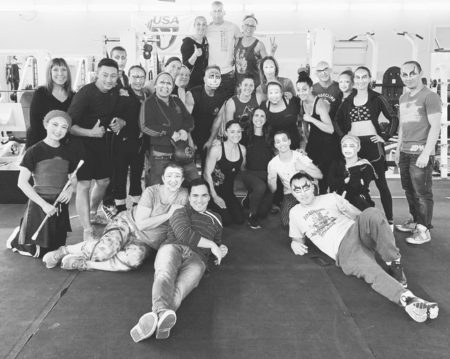
Often, aerialists and contortionists are dealing with previous knee and hip injuries that occurred because they didn’t develop the strength needed to prevent them. So, if we can help them get stronger in their lower body, we can help them deal with these existing issues and help prevent new ones from occurring.
If you had to single out just one, what’s something you’ve learned from working with Cirque du Soleil?
How quickly they learn because they’re such competent movers. It often takes someone who’s new to kettlebell training a long time to nail the fundamentals of the get-up, but I can teach it to these performers in a single day. Sometimes in the “O” show, they do a human get-up in their act—they’re literally lifting another human being. That’s obviously very hard on them so they cannot practice it much. Doing a kettlebell get-up allows them to groove a similar pattern without the same level of wear and tear on their bodies. They also catch on very quickly to some of the more dynamic movements that we typically don’t learn how to teach until the SFG Level II Certification.
Compared to performers, how different is your approach when starting from scratch with everyday folks?
Step one is always to make them feel more comfortable. If they’re new to strength training or using kettlebells, they’re likely very nervous when they come in for the first session, so I need to help them overcome that. Then it’s a matter of breaking down the basic movements into parts that they can understand. This allows them to have success right from the get-go, and to walk out feeling like they accomplished something and did better than they’d expected. This way, they’re eager to come back.
It’s not just about the skill component, but also being strong enough. People often tell me, “I’m so weak right now”, in which case I need to help them feel they can do this. Again, this goes back to setting small, achievable goals based on where they are right now.
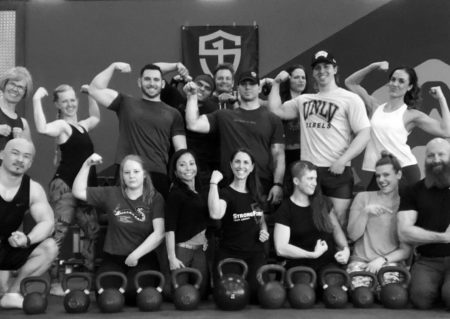
I got my bachelor’s degree in psychology and I feel the mental aspect of coaching is something that’s often overlooked. Yes, we do need to help clients understand the skills we’re teaching, but we also need to recognize that they’re humans who struggle with self-doubt and other limiting issues. If I can help people overcome their own mind, I can help them change their body, as well.
How do your backgrounds in ballet and kung fu feed into your kettlebell practice?
They’re both skills that require repetition to hone and refine your skills. As soon as I started training with kettlebells, I noticed this correlation. Just as in kung fu, the first time I tried the swing it felt slow and awkward. But I knew that if I kept coming back to it and practiced that same movement over and over again, I’d improve. It takes time and patience to put the pieces together. If you watched a new student do form one in kung fu, they’d probably be moving so slowly that it’d look more like tai chi, whereas a master performing the same movement sequence would be fast and fluid. What you wouldn’t see behind the scenes is all the repetition that the master did to dial in the skill aspect. The same is true in kettlebell training.
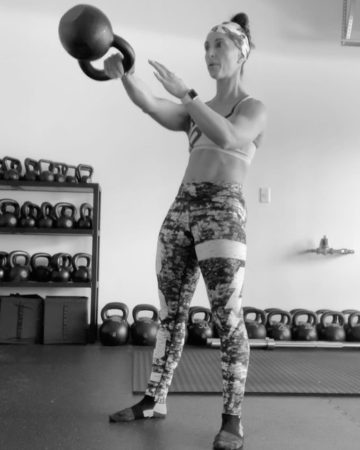
You’re the lightest woman to overcome the Iron Maiden Challenge. What was the key to your preparation?
From a physical standpoint, it was all about consistency, which is one of the most important StrongFirst principles. But I think the psychological component was just as important, if not more so. I had to confront doubts and the times when I’d ask myself, “Can I do this?” head on. I built confidence by starting with the movements that came easiest to me: the pistol and pull-up. Then once I had these down, it gave me the self-efficacy to keep going with the press. I hit the pistol standard in 2012 and then the pull-up in July 2013, but the press came much more slowly.
For a while, I was fixated on doubting if I could even get the weight overhead, let alone with correct technique. That made me lose sight of the skills I’d learned through StrongFirst education, which I needed to get me there. The turning point came when I failed at my first attempt at the press; it was at a certification, and there were a lot of students and fellow coaches there. Falling short that time convinced me to start from scratch. It wasn’t a strength issue—I just wasn’t doing the movement correctly.
So, I went back to pressing from a half-kneeling position with a 12kg bell. Then I started doing a ladder of 12, 14, 16, and 18kg. After three months, I felt I was finally ready to stand again. I did 20kg fairly easily and thought, “Now THAT is what a press is meant to feel like!” There was a moment when I considered walking away because I didn’t feel capable and was frustrated with myself, but I came back to my training, completely re-worked my press, and did what Master StrongFirst Certified Instructor Jon Engum often advises—turned my weakness into my strength.
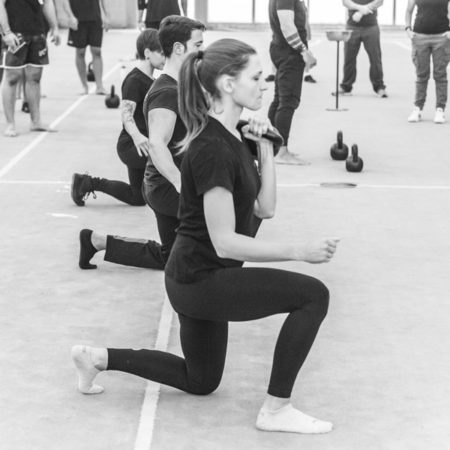
What does your training look like now?
I train five days a week. One day I’ll do heavy two-hand swings; the next a light-to-heavy two-hand swing ladder. The third day is heavy one-hand swings, and the fourth is a light-to-heavy one-hand swing ladder. The fifth day is snatches. Then I’ll work in double-bell presses and front squats, pull-ups, and get-ups. When it’s cooler here in Vegas, I’ll swap out a day of swings for a second snatch session, but at this time of year it’s hot and my hands get torn up if I snatch too often.
What’s the most gratifying thing about coaching your I’m Not Afraid to Lift course?
I just taught one this past weekend and it continues to remind me of why I became a coach in the first place: to help people do more than they think they’re capable of. One attendee had started running marathons with her sister, which is great, but didn’t feel strong. It was her first time trying assisted pull-ups and she was really reluctant to get on the bar. I kept encouraging her, and when she tried, she got a good, clean rep. She was delighted and said, “I didn’t think I’d be able to do it!” That sums up the entire weekend.
I want to show them that the more times we can show up and have positive experiences, the more efficacy we build—not just in training, but also in life. If this lady can do a band-assisted pull-up, maybe there’s something else that she’s been holding back on that she now thinks she can do after all.
Another thing I teach is that our fear of embarrassment if we try something and are unsuccessful is holding us back in so many ways. While it’s natural to fear failure, if you just show up, you will either meet or exceed your expectations, or have a valuable learning experience that expands your skill set. When you reframe it like that, there is no downside. Once people get strong, it helps them to be braver in trying new things.
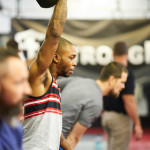
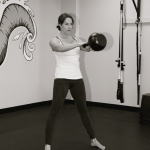
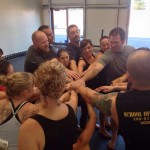





Hi Leonardo, The half kneel position helped me to stop focusing on just getting the weight overhead and brought me back to focus in on dialing in the StrongFirst principles for pressing such as hardstyle tension techniques like wedging. It’s harder to compensate in the half kneel position so you are forced to use good technique. ~Artemis
Thanks Artemis! That makes a lot of sense. I’m going to give it a try.
Congrats Artemis on your accomplishments! You mentioned that you went back to pressing from a half-kneeling position. What is the purpose of this form of pressing?
Brett Jones mentioned in an article that it’s a good way to check contralateral stability but I’m not sure what that means or how it helps with the standing press. Thanks 🙂